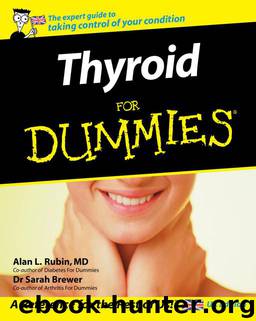Thyroid for Dummies by Rubin Alan L

Author:Rubin, Alan L. [Rubin, Alan L.]
Language: eng
Format: epub
Published: 0101-01-01T00:00:00+00:00
Chapter 15: Living with Thyroid Problems: Diet and Exercise 177
In fact, waist size alone is a good indicator of health. Research suggests that men with a waist circumference larger than 102 centimetres and women with a waist circumference larger than 88 centimetres are more likely to have shortness of breath, high blood pressure, high cholesterol levels, and diabetes than those with slimmer waistlines. Slight waist reductions of just 5–10 centimetres can significantly reduce your risk of a heart attack.
Losing excess weight
The best way to lose weight permanently is to change your eating habits, so you eat more healthily without feeling as if you’re actually on a diet. Look on losing weight as a healthy eating plan for the rest of your life, rather than a temporary slimming phase.
Importantly, to lose weight you also need to increase your level of physical activity. Exercise burns off excess calories and boosts your metabolic rate as well as improving the fitness of your heart and lungs. Try to exercise for at least 30 minutes on five days per week. Once you are fit, aim to do more. Start off slowly if you are unfit, and build up to exercise briskly enough to work up a light sweat and make yourself slightly breathless. Try these effective forms of exercise:
ߜ Brisk walking
ߜ Cycling
ߜ Swimming
ߜ Dancing
ߜ Vigorous housework
ߜ Gardening
Don’t set yourself unrealistic targets. At first, just aim to stop your weight increasing and prevent the downhill spiral. Then look at how you can slowly lose the pounds – just one or two pounds per week soon adds up to a significant weight loss over the coming months.
Selecting a variety of foods
You’ve probably heard the phrase ‘eat a balanced diet’ many times, but what exactly does that mean? Eating a balanced diet just means eating enough of the right sorts of foods, in the right amounts, to provide all the energy, carbohydrate, protein, fat, vitamins, and minerals you need on a daily basis. A healthy, balanced diet gives you:
21_031727 ch15.qxp 9/6/06 10:47 PM Page 178
178 Part III: Managing Your Thyroid
ߜ Enough energy to fuel your level of physical activity and maintain a healthy weight
ߜ Enough protein for tissue repair, regeneration, and rejuvenation ߜ Enough essential fatty acids (omega-3) that your body is unable to produce itself
ߜ At least the recommended daily amount of vitamins and minerals ߜ Enough fluid to maintain a normal water balance
Different people need different amounts of foods depending on their level of physical activity – both at work and leisure – their height, weight, age, and the metabolism they have inherited. In general, however, most people benefit from eating:
ߜ More starchy (complex or unrefined) carbohydrates, such as wholegrain cereals
ߜ More fresh fruit and vegetables
ߜ More unsalted nuts and seeds
ߜ More fish, especially oily fish
ߜ Less fat, especially saturated fat
ߜ Less processed, ready-made products
Most people obtain more than enough protein from their diet, and cutting back on fatty foods and those that are protein-rich helps to make room for more fruit and vegetables.
The food proportions that help to make up a balanced diet are illustrated on a plate diagram.
Download
This site does not store any files on its server. We only index and link to content provided by other sites. Please contact the content providers to delete copyright contents if any and email us, we'll remove relevant links or contents immediately.
Men In Love by Nancy Friday(4969)
Everything Happens for a Reason by Kate Bowler(4481)
The Immortal Life of Henrietta Lacks by Rebecca Skloot(4264)
Why We Sleep by Matthew Walker(4193)
The Sports Rules Book by Human Kinetics(4081)
Not a Diet Book by James Smith(3156)
The Emperor of All Maladies: A Biography of Cancer by Siddhartha Mukherjee(2934)
Sapiens and Homo Deus by Yuval Noah Harari(2854)
Day by Elie Wiesel(2598)
Angels in America by Tony Kushner(2395)
Endless Forms Most Beautiful by Sean B. Carroll(2353)
A Burst of Light by Audre Lorde(2350)
Hashimoto's Protocol by Izabella Wentz PharmD(2206)
Dirty Genes by Ben Lynch(2164)
Reservoir 13 by Jon McGregor(2149)
And the Band Played On by Randy Shilts(2020)
Wonder by R J Palacio(1993)
The Immune System Recovery Plan by Susan Blum(1971)
Stretching to Stay Young by Jessica Matthews(1948)
